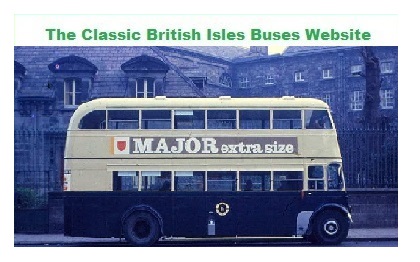

The Classic British Isles Buses website
Dublin routes 29, 31 and 32 (by Shane Conway)
Last updated on 19 August 2024
Email Classic U.K. Buses Classic Irish Buses Classic Manx Buses
| Leyland and Volvo Olympians fleet history | Howth Road route history | A pictorial review of routes 17, 18 and 75 |
With the 2021 start of the new Dublin area Bus Connects route network, this page takes a look at the history of the first routes to be changed, namely those linking the city centre with Killester, Raheny, Sutton, Howth and Baldoyle, numbers 29A, 31, 31A and 32.
My interest in the topic of this page started in the early 1960s, having been born and living in the Raheny area in that momentous decade. Regular Saturday trips to the city were undertaken from the bus stop nearest our then house (nowadays stop number 597), with stop 538 being its equivalent drop off point on the outbound journey. Back then the 31 and 32 routes both served the area, mostly with Leyland OPD2s, or occasionally AEC Regents. Now, at the time, a few were still in the old green livery, but most had been repainted in blue and cream. Some buses had a large single destination screen, others the upgraded triple box display. Added to that was the point that a few of the AECs had platform doors (possibly they ran with the doors locked in the open position), but none of those points actually registered deep in the mind of a three or four year old lad at that time. To me the main difference was whichever route number was displayed. On a couple of occasions a 29 bus was used instead for the outbound trip, with a longer walk home from Raheny village. Among the buses allocated to the 31 at that time was Leyland OPD2 R827, which I must have travelled on at some time or other. I was later to be reacqauinted with the bus when it was being restored in the 1980s, following which I did several stints as conductor on it at various vintage road runs. Sadly today, it is dumped in a yard in north Dublin, unloved, unwanted and slowly decaying to the point of no return.
On one day in the spring of 1967 we were on an outbound journey, with me sitting on the nearside wheelarch seat with a good vantage point through the back window. On that trip, between Killester and Raheny a city bound 31 passed us. Not just any bus mind you, but a brand new D class Leyland Atlantean!! Clontarf never had any allocated, so presumably it was just a bus which was being assessed, or loaned to cover an extra duty. Had we waited in town for a further half hour that day we could well have been able to get a trip on it. To this day I have never been able to identify which bus it actually was. Another unusual sighting around that time was encountering two Leyland Tiger half cab single deck buses parked together at a stop in Lower Abbey Street as we headed to get the decker home. I was amazed by those, as it was the only time I ever saw any of them close up. 1969 saw our family pack up and leave the area for a more rural location away from north Dublin. The last time I witnessed an OPD2 in service in the area was on a night in 1973, as my father was leaving a friend's house near Blackbanks. In the distance on that calm night I could hear an approaching Leyland O.600, and sure enough an OPD2 quickly drove past, all saloon lights lit up. A magnificent sight, but one which was soon to disappear.
Public transport in the area commenced in 1844 with the building of a railway from Dublin to Drogheda which opened on May 25th that year. Three years later a branch line was added to link Howth to the mainline from May 30th 1847. The early 1900s saw two tram routes added in the area, the first linking the city with Howth via Clontarf and Dollymount starting on July 26th 1900. In June 1901 a scenic tram route started, linking Sutton and Howth railway stations by a five mile route around the Hill of Howth, giving spectacular views across Dublin Bay towards County Wicklow. Both of these tram routes crossed each other twice, firstly on the level at Sutton Cross and secondly by means of a bridge beside Howth station. In 1918 the Dublin United Tramways Company allocated route numbers to its services, with the Howth route becoming 31.
The first bus service in the area started on July 7th 1925, with the D.U.T.C. starting its first bus route (43) which linked Killester and Eden Quay. On March 25th 1929, the Great Northern Railway started a route from Eden Quay to the East Pier in Howth. For some of its journey it paralled both the 43 bus and the Dublin to Howth tramway, but turned off at Fairview to serve Killester and Raheny before rejoining the 31 tramway route at Blackbanks. Two months later the G.N.R. started a second bus service, this time to Portmarnock, which shared the same route as the Howth buses as far as Baldoyle Road, from where it turned left and served Baldoyle en route. Certain journeys on this route were extended to terminate in Malahide. On the same day a second route to Malahide also opened, this one leaving the Howth route at Fairview and travelling inland via Coolock and Artane to reach Malahide from the opposite direction to the coastal route. The D.U.T.C however had been on this route (42) since 1925, so in due course the route was to become jointly operated, which lasted until 1941. The 43 (and route 75 City Centre to Kimmage) were merged in 1939 and renumbered 54 and 54A, the southern end of the route having two termini, at Kimmage Road West and Fortfield Drive respectively. These routes were (until 1971) operated jointly by Clontarf and Ringsend garages, after that it passed to Summerhill garage, and was later progressively cut back to run from the City Centre to the south city. Its former terminus at Killester was later removed during road junction alterations.
Initially the G.N.R. buses on these routes were all single deck vehicles, starting with Leyland PLSC Lions for a short while, until half cab AEC Reliances took over. This started a link between AEC buses and these routes, which was to last for almost 40 years until the late 1960s. August 15th 1935 saw the start of a route from Eden Quay via Raheny to Hole in The Wall Road. The then very rural section beyond Raheny meant this route operated on a limited basis. Other route licences of the era are really outside the scope of this page, but included church buses on Sundays, buses to Baldoyle race course as required and extra seaside specials to the coast in the summer in an era of low car ownership. An infrequent variation of the Howth route began in the mid 1930s, buses turning right at Sutton Cross to terminate on nearby Strand Road.October 1937 saw the introduction of two Park Royal bodied AEC Regents on the Howth route, about two months before the D.U.T.C. put its first Leyland TD4s into service. Early 1938 saw a vehicle swap between D.U.T.C. and G.N.R., involving G.N.R. 62 and D.U.T.C. R6 for evaluation purposes for a short period. Four more Regents arrived in the summer of 1939. These six deckers were exclusively on the Howth route, with Malahide having only single deck buses.
In 1941 the Dublin to Howth tramway ceased operating. At this point the G.N.R. withdrew from the jointly run Malahide service, in return the D.U.T.C. didn't provide a route 31 bus service to replace the trams. The D.U.T.C. became part of C.I.E. in 1945, but no major changes happened as far as the Howth Road routes were concerned. The Howth route saw two interesting buses in use around 1948, with the loan of two Alexander bodied Leyland PD1s from Lough Swilly in Donegal. This duo had been partly assembled in Letterkenny and then brought to C.I.E. in Dublin to be completed, prior to the G.N.R. loan. Further AEC Regents were bought by the G.N.R. after the war, some of which replaced the older buses on the Howth route. At the same period a batch of 30 AEC Regal IIIs were placed in service, some at least going on the Malahide route.
During the 1950s the G.N.R. placed further new buses in service, including Regal IVs and more Regent IIIs. 1956 saw the purchase of five Leyland TD5s from C.I.E. which were used on a new route via Raheny which then did a loop of the side roads east of the village before terminating at Saint Anne's Park. After 1965, the outer section of this route was reversed, covering the side roads first, and terminating at Raheny Church. The late 1950s saw the commencement of new housing developments in the area, and thus extra capacity needed on the bus services. On September 30th 1958 the G.N.R. ceased its seperate existance, being taken over by C.I.E. Now their services finally received route numbers, with the Saint Annes route becoming 29, and Hole in the Wall became 29A (quickly renamed on blinds as Grange Road Cross, with some journeys later being altered to terminate at Newgrove Cross). Howth became 31, as in tram days, Strand Road became 31A, and 32/32A was applied to the Portmarnock road service, the suffix route denoting those journeys which went to Malahide. Short workings to Baldoyle were identified as 32B from December 1967 onwards. Some 31 journeys were routed via Clontarf, although most stayed on the ex G.N.R. route. The G.N.R. buses operating in the area were transferred to Clontarf garage. The Hill of Howth Tramway closed down at the end of May 1959, and two new bus routes (87 and 88) introduced. Each route was allocated a modified PD2 with higher gearing to cope with the severe gradients to Howth Summit. A few years later, following road improvements, the 87 was withdrawn and 88 extended to cover the entire route.
C.I.E.'s last new Leyland OPD2s entered service in late 1958, some of which were sent to Clontarf. As it turned out, these would be the last new buses in the garage for over fifteen years, fleet replacement being made possible between 1959 and 1974 by cascading buses from other depots where brand new buses had replaced them. One issue in Clontarf was lack of space, inspection pits being unsuitable for PD3s and Atlanteans at that time. By the early 1970s it was becoming clear that the garage would have to be altered to cope with longer buses, and so this allowed the replacement of OPD2s with PD3s. The first Leyland AN68s were then in build, and it was initially planned they would go to Phibsboro garage to allow cascading of a batch of eight to ten year old PDR1s to Clontarf. After a bit of discussion by Clontarf management, it was agreed that the AN68s would instead go new to the coastal garage and the first ones entered service on route 31 in December 1974. By February 1975 the 29 route duties had been added to the 29A schedule, and the 29 consigned to the history books. New route 29B started at this time, covering 29A and continuing to a terminus at Howth Junction station. The service, which lasted until June 1984, only operated after 20.00 Monday to Saturday and all day on Sundays, and was aimed at surburban rail passengers during an era of a much reduced train service. Over the space of 30 months, the bulk of Clontarf's OPD2 fleet was replaced by a mix of cascaded PD3s and new AN68s. The latter buses ushered in a new livery of allover tan, and brought a new era of travel to the 31 and 32 routes. The end of the Dublin based OPD2s occurred at 23.30 on June 15th 1976, when R813 arrived back to the garage for the last time.
For the rest of the 1970s the Howth Road routes were mainly covered by the D class AN68s, but with occasional sorties by a PD3, much to the delight of enthusiasts of the time. The Howth terminus was then at the church on Saint Mary's Road. With a need to oust the last halfcabs from the fleet, the Detroit Diesel powered Bombardier deckers commenced delivery in early 1981, and the sight and sound of these was a radical difference from anything that had gone before. The final PD3 to work for C.I.E. was RA95 which did a couple of enthusiasts specials on the 31 on April 2nd, 1982. With its withdrawal, the entire C.I.E. double deck fleet was now rear engined, comprising tan coloured Atlanteans and green Bombardiers. On February 2nd 1987, all C.I.E. bus services in the Dublin area passed to Dublin Bus. An orange stripe was added to the two tone green livery on the Bombardiers, and this was then adopted as a new livery to replace the dull scheme on the Atlanteans. Route 88 was axed in mid 1988 and replaced by new route 31B, which turned right at Sutton, went up Carrickbrack Road and then downhill to Howth village and terminated at the railway station. Around the same time some 31 journeys were extended up the hill to terminate at the Summit, this later applied to every run. The network direct revisions around 2011 saw the 31B altered to go directly to Howth and terminate at the Summit, being eventually reduced to a handful of three Monday to Friday evening peak hour workings from the City Centre, with two runs back in the same time period, plus three morning journeys following the older version uphill from the station but serving Strand Road on their way to Sutton Cross. In replacement the 31A was altered to start from Shielmartin Road, go to the Summit and continue on the 31 route to the City Centre.
1990 saw the introduction of new Alexander RH bodied Leyland Olympians, which were utilised throughout the Clontarf route network. In the late 1990s the 29A was extended from its two termini of Grange Road Cross and Newgrove Cross to terminate in Baldoyle. From 2000, new longer Alexander ALX400 bodied Volvo B7TLs started joining the fleet, with deliveries continuing up to 2006. After that came a batch of 100 Alexander Enviros, before allegiance was switched to the products of Wrights of Ballymena, these now make up the bulk of the fleet. The two tone green of the early Dublin Bus era gave way to a cream, orange and blue livery from 1997 onwards. This in turn was replaced by a new scheme of yellow and two shades of blue in the 2000s, and this in turn is now giving way to the current Transport for Ireland colours of mostly green with a yellow front and white squiggles on the sides. June 26th 2021 saw the end of the traditional route numbers in the area, with 29A, 31/31A and 32 becoming H1, H2 and H3 respectively under the bus connects system from the following day. New orbital route 6 also started, basically following the old 88 from Howth to Sutton, then the old 31 tram as far as Watermill Road, then roads around Raheny while avoiding the village itself and finally back onto the H3 bus route from Sybil Hill Road towards the City Centre. Some of its routing has not seen regular bus services for many years, indeed some roads are getting a service for the first time ever.
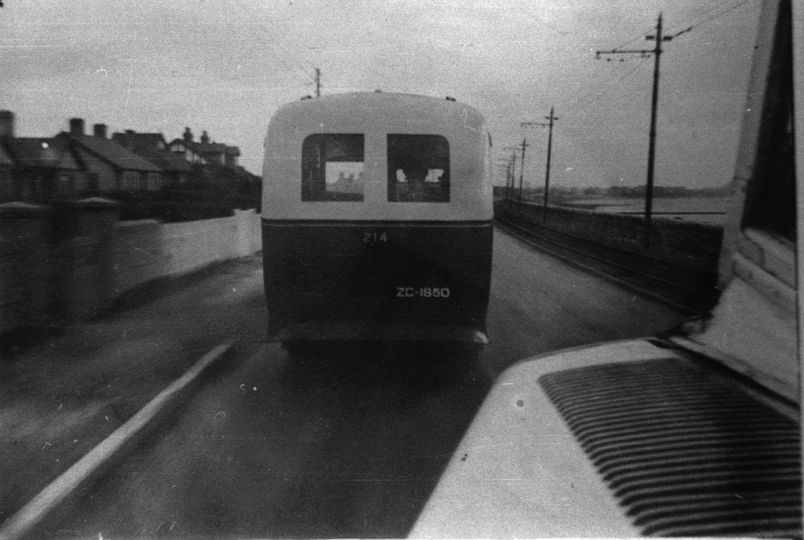
G.N.R. Gardner 214 was new in July 1937 and is seen here between Blackbanks and Sutton Cross, most likely on the Malahide service. Note the Howth tram line on the right of the photo, which closed in 1941. 214 was withdrawn in 1953, and sold to the Sligo, Leitrim and Northern Counties Railway, where it saw three more years service. Photo copyright unknown.
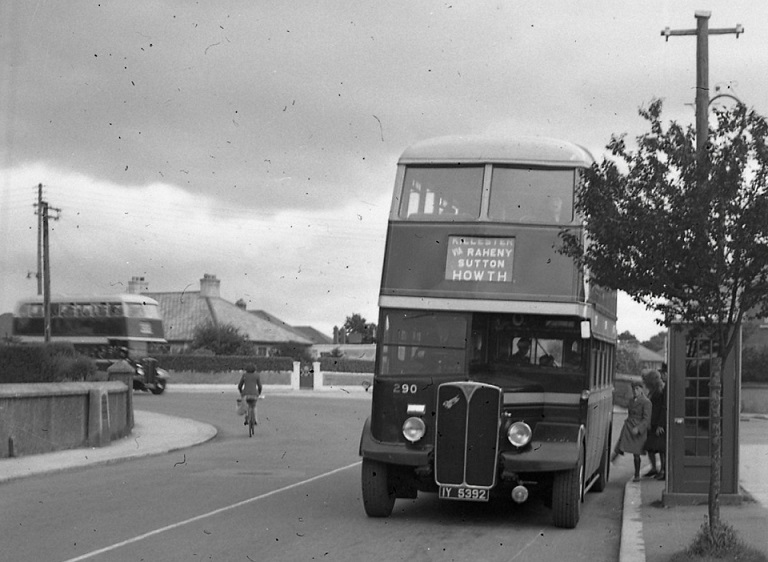
Prior to October 1958, the services to Howth were provided by the Great Northern Railway. AEC Regent III 290 is seen at the junction of Howth Road and Castle Avenue in Killester on a Howth to Dublin service, with a second similar bus in the background. Photo copyright Bob Laird collection.
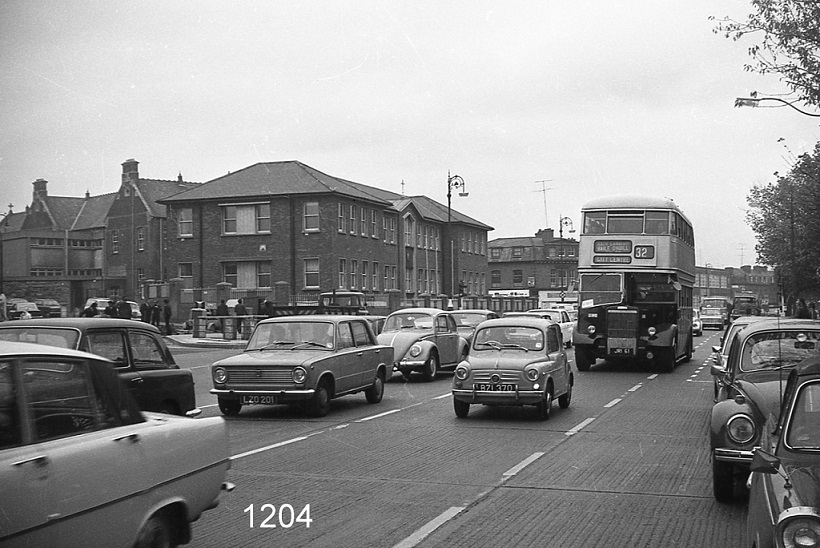
A late 1960s scene at Fairview Park, with C.I.E.'s R631 citybound on route 32. A fine selection of Fiat, Austin, Rover, Triumph and Volkswagen cars can also be seen in this photo. Photo copyright Bob Laird collection.
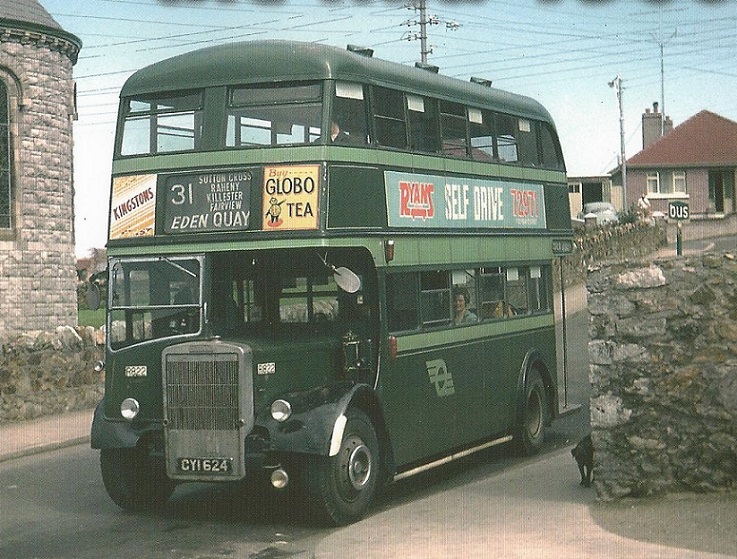
The Howth terminus in C.I.E. days was at the church on St. Mary's Road, this location continued to be used by Dublin Bus up to around 2000. The buses used in the early 1960s were like this, a two tone green Leyland OPD2/10 (R822) which was new in 1958 as part of a batch of 35. Note this batch had a different upper deck front window layout to that of the older examples, such as R631 above. Photo copyright Bob Laird collection.
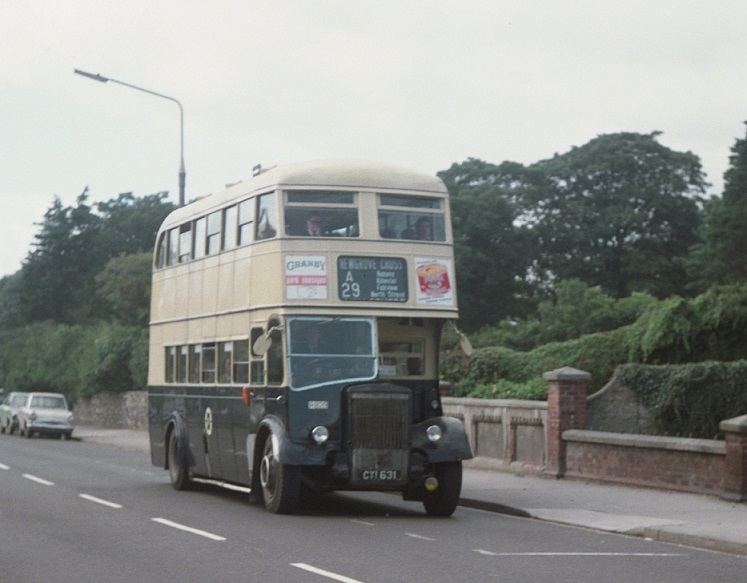
Seen approaching the junction of Howth Road and Copeland Avenue is C.I.E. R829 on route 29A, by now in the later blue and cream livery, but still retaining its single pane destination screen. Photo copyright Bob Laird collection.
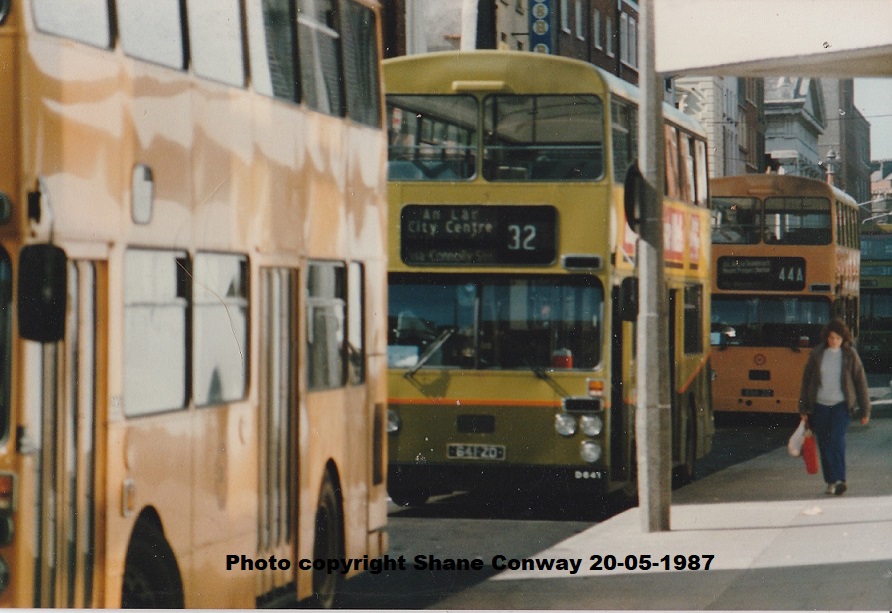
From 1974 onwards Van Hool McArdle bodied Leyland Atlantean AN68s began ousting the older Leyland Titans from the area. D641 was new in February 1975 and is seen twelve years later in newly applied Dublin Bus two tone green, parked on Marlborough Street between duties. D641 was withdrawn in June 1994 and sold for scrap.
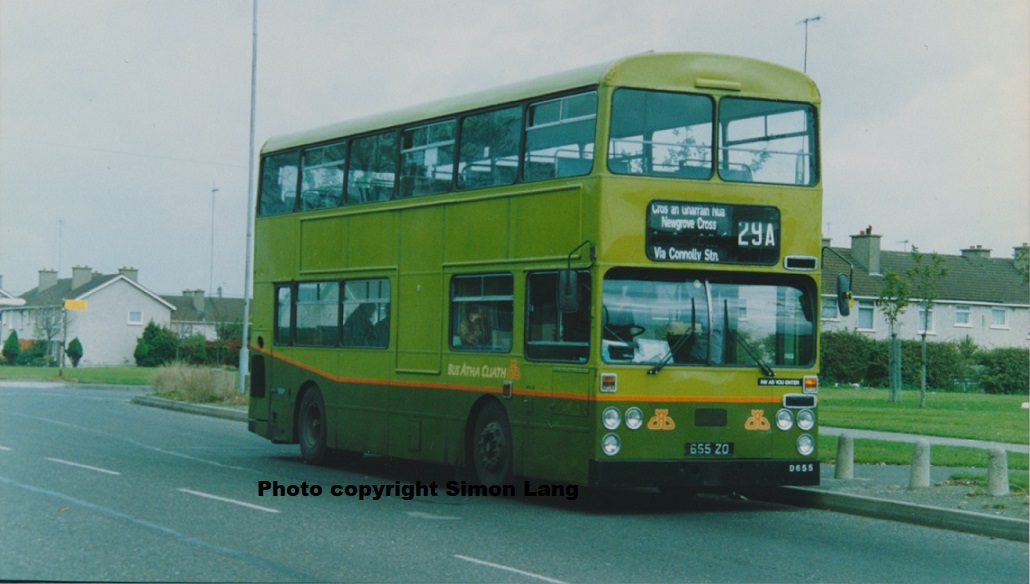
From 1974 onwards Van Hool McArdle bodied Leyland Atlantean AN68s began ousting the older Leyland Titans from the area. D655 was new in January 1975 and is seen in the early 1990s in the Dublin Bus two tone green, parked at the 29A terminus at Newgrove Cross. By this time the bus has been fitted out for driver only operation.
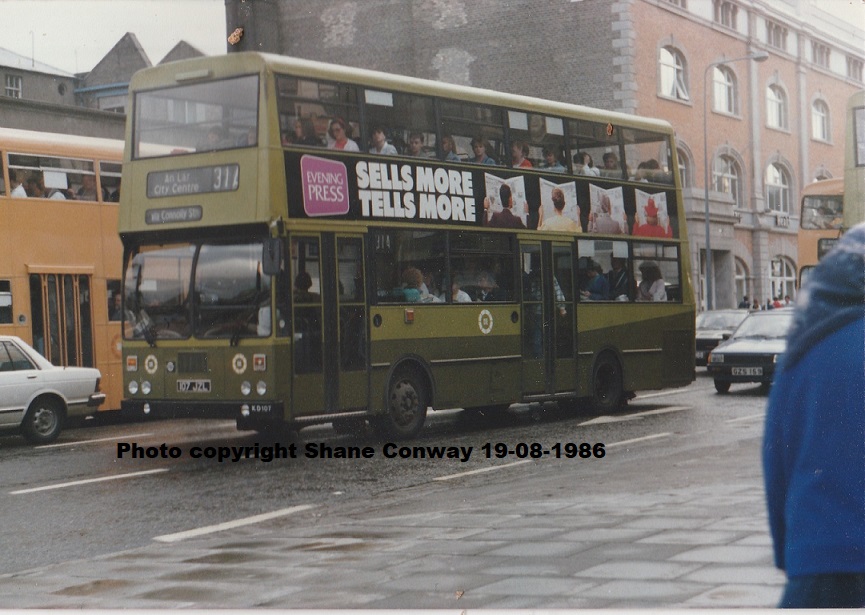
The new order from 1981 onwards was an eventual fleet of 366 of the KD class Bombardier double deckers, the ones going to Clontarf being replacements for their last PD3 Titans. KD107 is seen here setting off on a busy run on route 31A, on Lower Abbey Street.
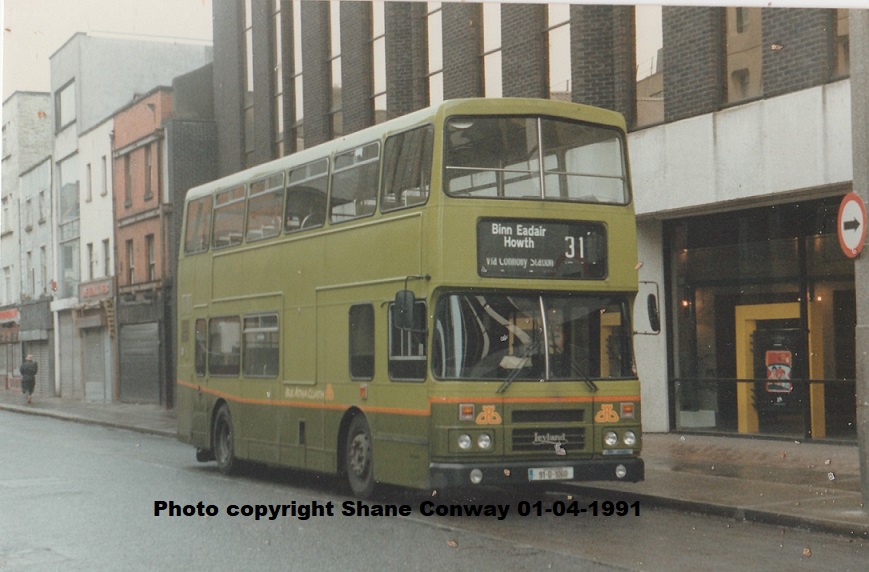
Dublin Bus's first new deckers were Leyland Olympians. RH60 was the first of the 1991 registered examples and was photographed on Marlborough Street on route 31 when just three months old.
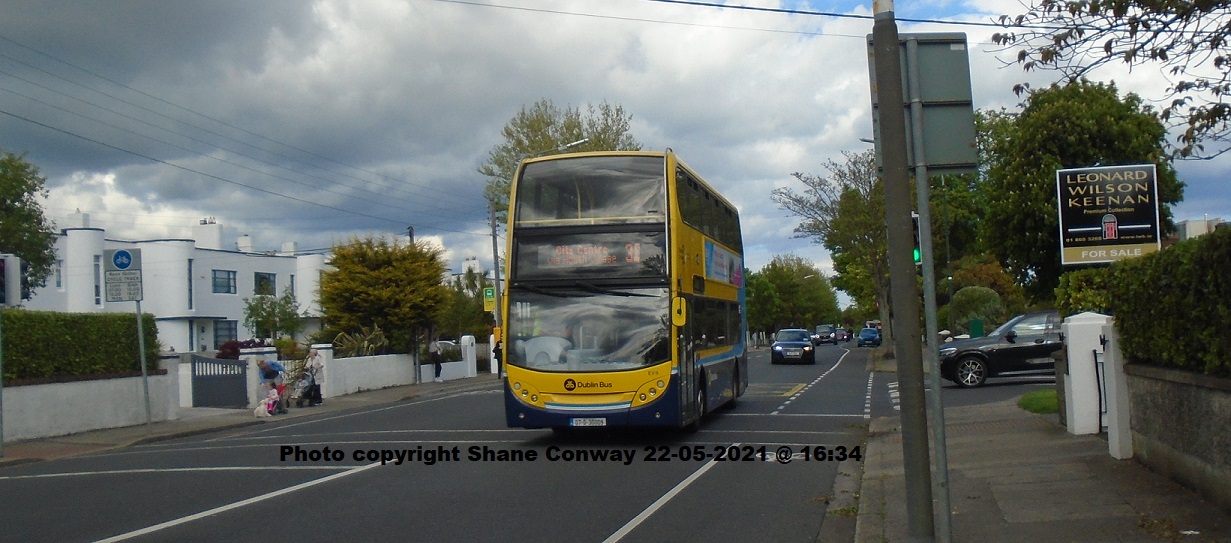
More recently the Dublin Bus fleet is almost entirely Volvo buses. In 2007 the company bought 100 Alexander-Dennis bodied Volvo B9TLs, numbered as EV1 - 100. Fourteen years later EV9 is seen approaching bus stop 597 between Blackbanks and Raheny, our boarding point on numerous occasions between 52 and 56 years prior to the date on the photo.
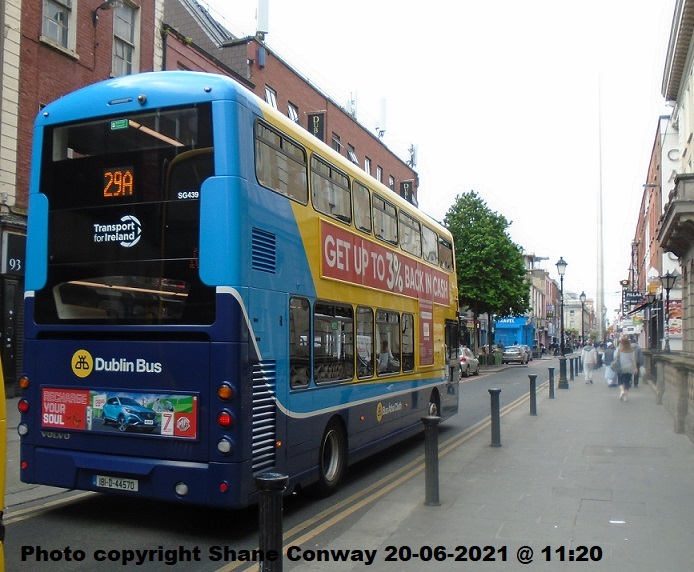
On the final Sunday of the old routes running, SG439 sets off on route 29A from Talbot Street.

The advert poster now adorning the sides of Clontarf buses in the new livery, promoting the H spine. Which apparently seems to be a new term for a group of bus routes serving the same road......
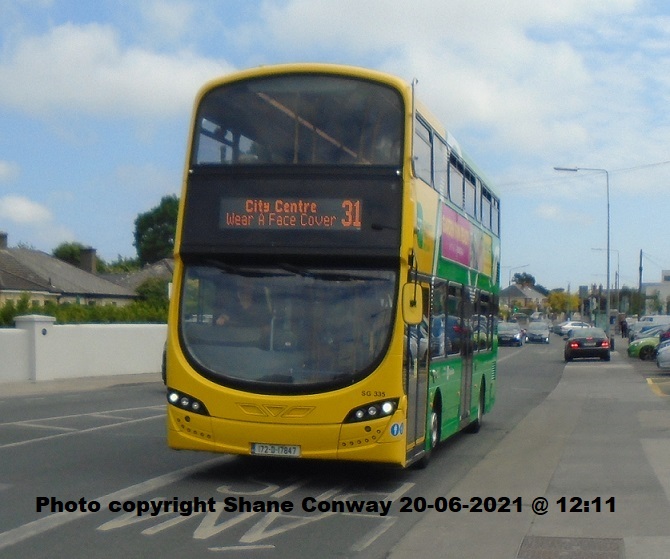
A few hundred yards (and about 65 years!) further on from where the GNR AEC Regent was photographed, Dublin Bus SG335 is seen working on the same route as the older bus. The AEC had 56 seats and a crew of two, the Volvo has 77 seats and is driver only. Progress??
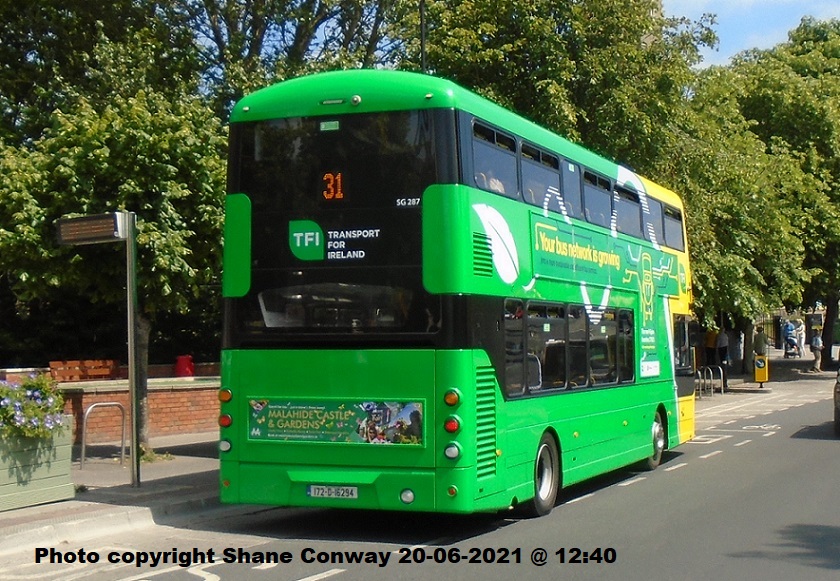
SG287 is seen at Raheny Church on route 31. Back in 1968 R287 was one of the last two green Titans in Clontarf garage, as was R284. Less than an hour before this photo I had also photographed SG284 in Talbot Street. Both pairs of buses have been in Clontarf, and all four in a green livery, co-incidentally.
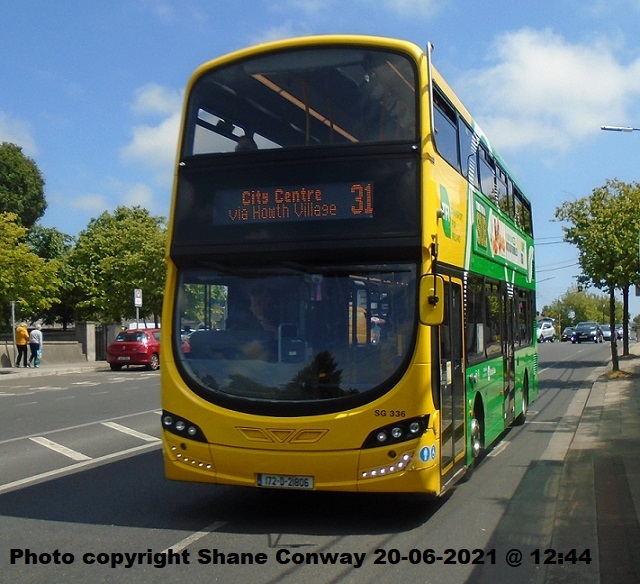
On the opposite side of the road to SG287, SG336 is seen on a city-bound 31 working four minutes after SG287 was photographed.
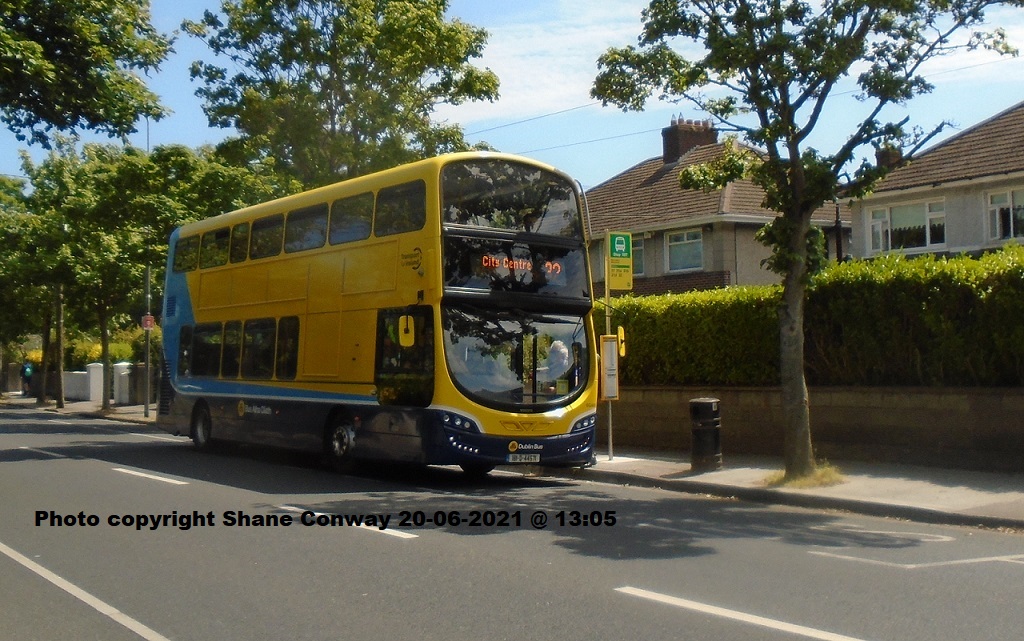
Seen at our bus stop is SG440 on route 32. Seeing this brought back memories of long ago journeys from this point on 1950s Leyland Titans. While the buses and bus stops have changed, the backdrop is still much the same as in the 1960s.
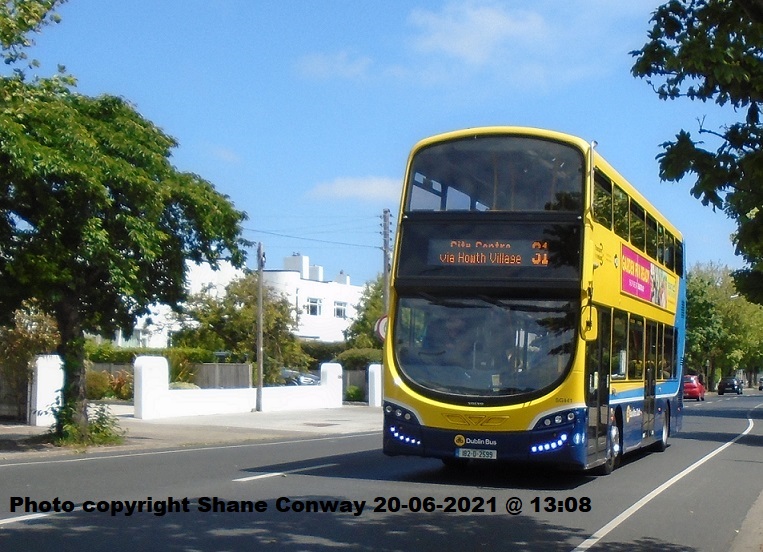
Just three minutes after SG440, along came SG441 on the 31, seen at the same spot as EV9 a month earlier. Note the flat roof Mediterranean style houses in the background, a feature of this area.
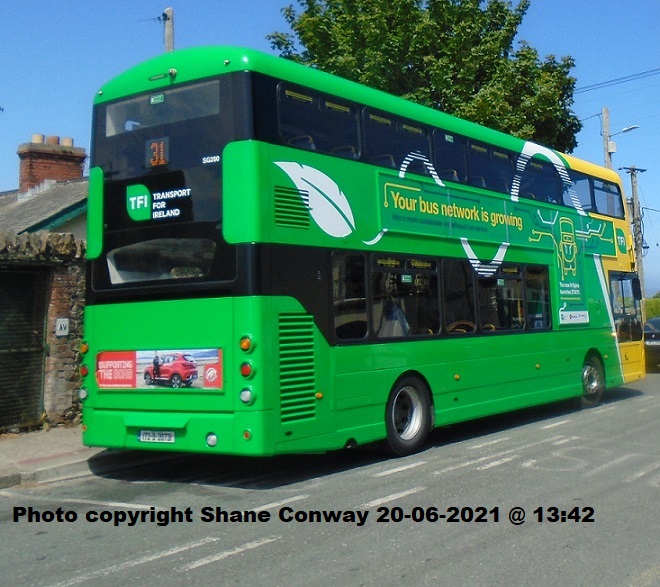
On to the final terminus of the 31, at Howth Summit which is a taxing climb up from the former location as seen in the photo of R822. Here SG280 awaits departure back down the hill to Howth village.
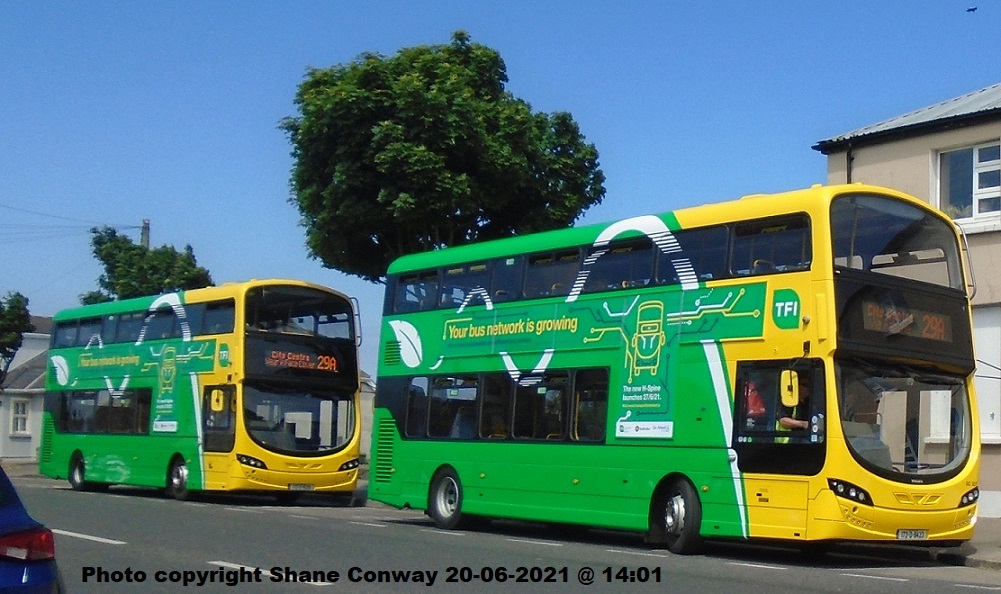
Finally, catching a pair of route 29A buses at their terminus in Baldoyle. SG307 with SG285 parked behind it, both in the new green and yellow livery.
So, 121 years after the first trams ran between Dublin and Howth, a new era dawns. It is also 92 years since the first G.N.R. buses reached that seaside village, just six weeks before my mother was born. The journeys she and I took in the mid 1960s introduced me to those long gone Leyland Titans. As these changes occur in 2021, it marks almost 63 years since C.I.E. buses first travelled through Raheny after the G.N.R. takeover. On a personal level our family had to organise our mother's funeral in May 2021, around six weeks before the new routes were introduced, so writing this page about the bus route changes has been somewhat poignant. Somewhere deep in my memory cells is an image of a young boy trying to read the destination scroll on an approaching distant Leyland Titan over 55 years ago. Over the years the buses have changed -- Titans, Atlanteans, Bombardiers, Olympians and Volvo B7TLs, and now the routes too. But the roads along which they travelled still bear a strong resemblance between then and now. What the future holds for the operation of routes H1/2/3 remains to be seen, but they have a very illustrious set of predecessors over more than a century. Interestingly, adding together 31 and 32 gives both the year I was born, and the number of years between the end of the G.N.R. and the start of H1/2/3. And adding 29, 31 and 32 gives the number of years between the first G.N.R. buses and the start of the H spine.
Farewell 29, 31 and 32, you will be missed.
Postscript -- one year on..........
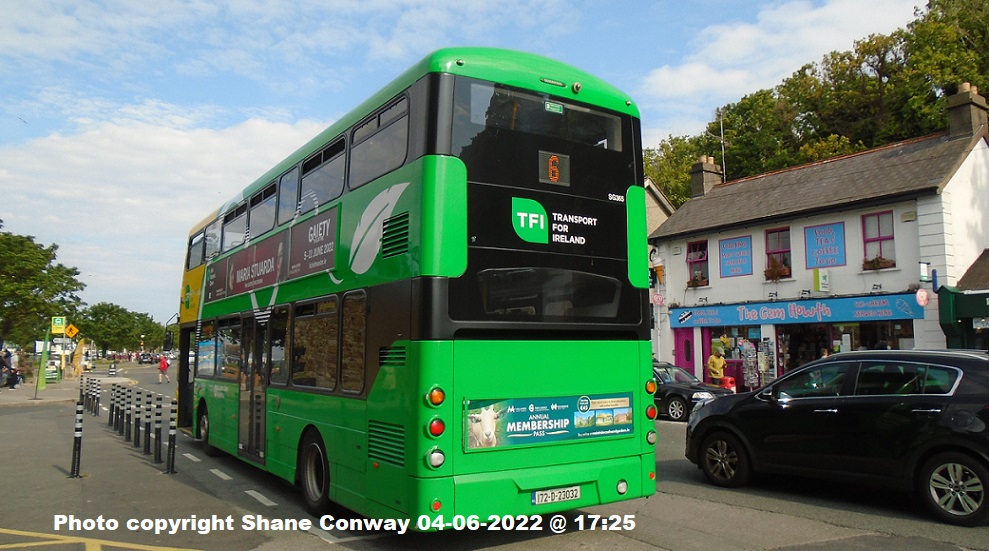
A visit to Howth on June 4th 2022 produced this sighting of Dublin Bus SG365 on route 6. Under the original D.U.T.C. route numbering system the 6 was Nelson Pillar to Blackrock, a number un-used for several years.
Email Classic U.K. Buses Classic Irish Buses Classic Manx Buses